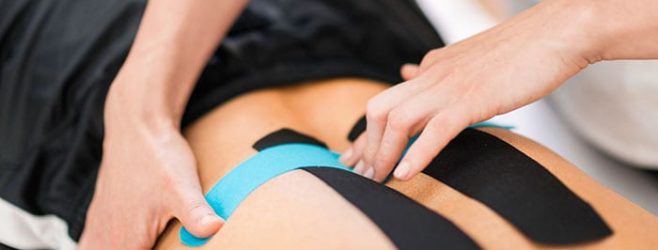Postural control is an essential part of development for children with cerebral palsy. Maintaining equilibrium not only improves orientation and balance when sitting or standing – equilibrium is, in fact, a huge factor in motor function.
Yet postural performance is very complex, and the required therapy or control might take several different forms. In the past, these have ranged from exercise and physiotherapy to posture-control insoles and even equine-assisted therapy.
Most recently, researchers have focused on posture improvement techniques for sitting, in particular. A study earlier this month examined the effects of Kinesio taping against neuromuscular electrical stimulation for the first time. But what are these methods, and how can they help children with cerebral palsy?
What Is Kinesio Taping?
Kinesio taping is a form of rehabilitation that’s designed to support muscles and joints. The process involves attaching latex-free tape to specific areas of the body, which microscopically lifts the skin. This method treats a variety of orthopedic, neuromuscular and neurological conditions by alleviating pain and inflammation in the somatosensory system.
Depending on the needs of the individual patient, the tape can remain in place for several days at a time. KT can help to ease anything from sports injuries to back problems – most importantly, without restricting motion at all. This means the tape is commonly used by athletes, but has also proven extremely effective for treating pain associated with cerebral palsy.
KT vs. NMES
This recent study, led by Dr. Murat Ersoz of Ankara Physical Medicine and Rehabilitation Training and Research Hospital, looked at the effects of Kinesio taping in relation to 2 other forms of therapy: neurodevelopmental therapy (NDT) and neuromuscular electrical stimulation (NMES).
Neurodevelopmental therapy is a long-established therapy for improving the posture and movement of infants and children with cerebral palsy. The NDT approach involves a therapist using gentle manual contact to assist the patient with muscle activation, weight shift and body alignment. But, although this therapy works well, researchers hope to take treatment a step further.
A group of 75 children, split into 3 smaller groups, took part in the study. Dr. Ersoz’s team applied NDT, KT, and NMES – a strength training treatment that sends electrical impulses to the nerves – to each group. The “control” group received only NDT treatment; the 2 others had KT and NMES in addition to NDT. The aim was to determine which, if any, treatments had the most positive effect on kyphosis (abnormal rounding of the back) and sitting.
The Results
After 4 weeks of treatment, the results were definitive: sitting ability had improved significantly in all 75 of the children. In fact, the most improvement was seen in the KT and NMES groups – and NMES was the most effective of all.
This means that for any children currently undergoing neurodevelopmental therapy, adding either KT or NMES to their course of treatment is definitely worth considering.
The good news is that neither treatment is invasive, nor difficult. Each comes with substantial benefits, too. Kinesio taping can prevent injury and promote good circulation and healing in the body, as well as reducing pain. And electrical stimulation is so effective in muscle rehabilitation that it can replace other therapies altogether.
What’s Next?
Posture control is fundamental for daily activity. So it’s safe to say that these treatments are making a huge difference to the lives of children with cerebral palsy. And from this study, children now have the opportunity to make leaps and bounds in movement, posture, and comfort.
Now we know that combining 2 treatments is both safe and practical for children with cerebral palsy. So what exciting possibilities can we expect in the future? Since children who had KT or NMES made the most progress, researchers now plan to test a combination of NMES and Kinesio therapy. Given the success of Dr. Ersoz’s study, it will be interesting to see how much more potential this will have for cerebral palsy therapy.
Before thinking about Kinesio taping or neuromuscular electrical stimulation, be sure to consult with your doctor to find out if these treatments are suitable for your child.



